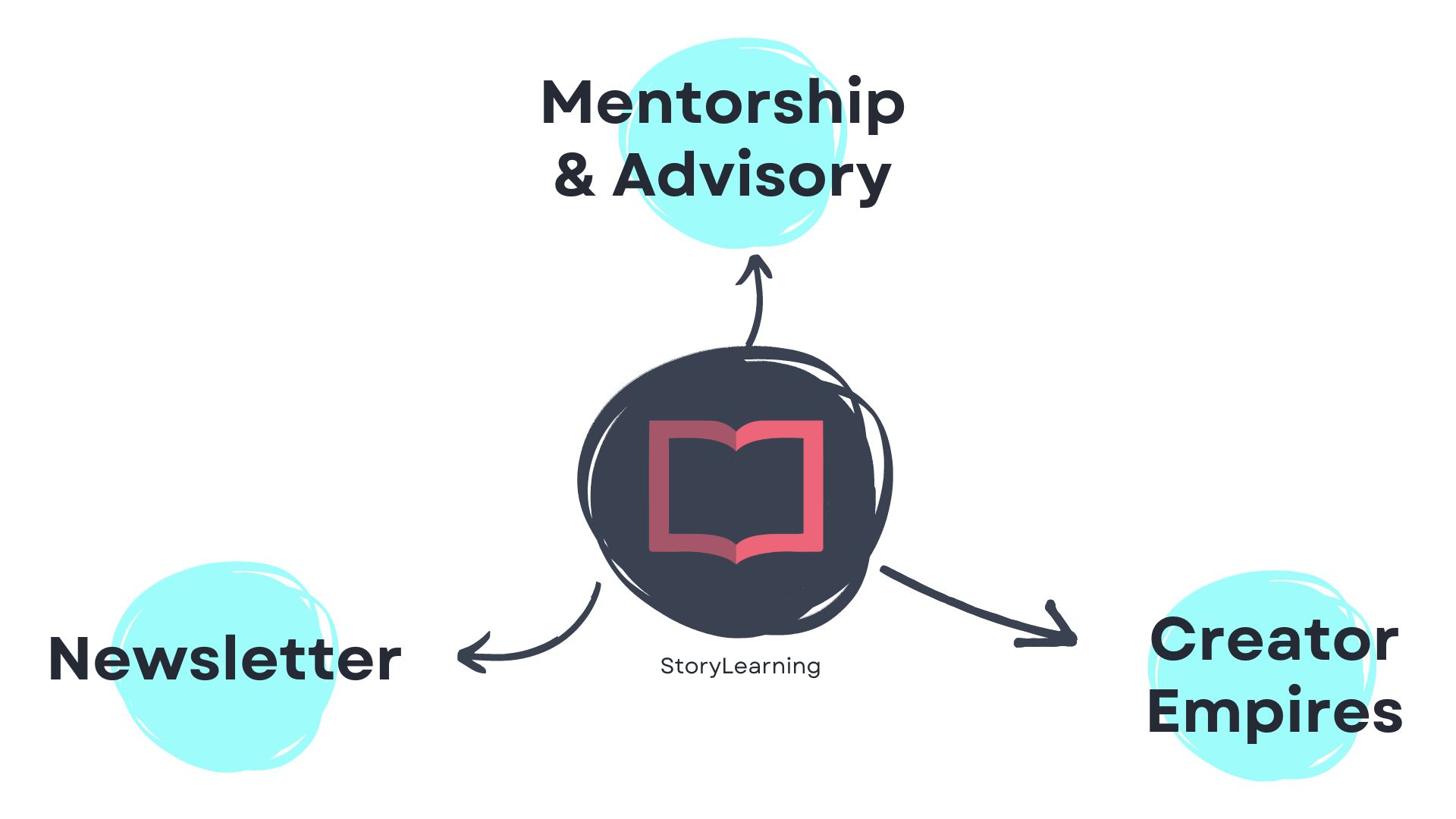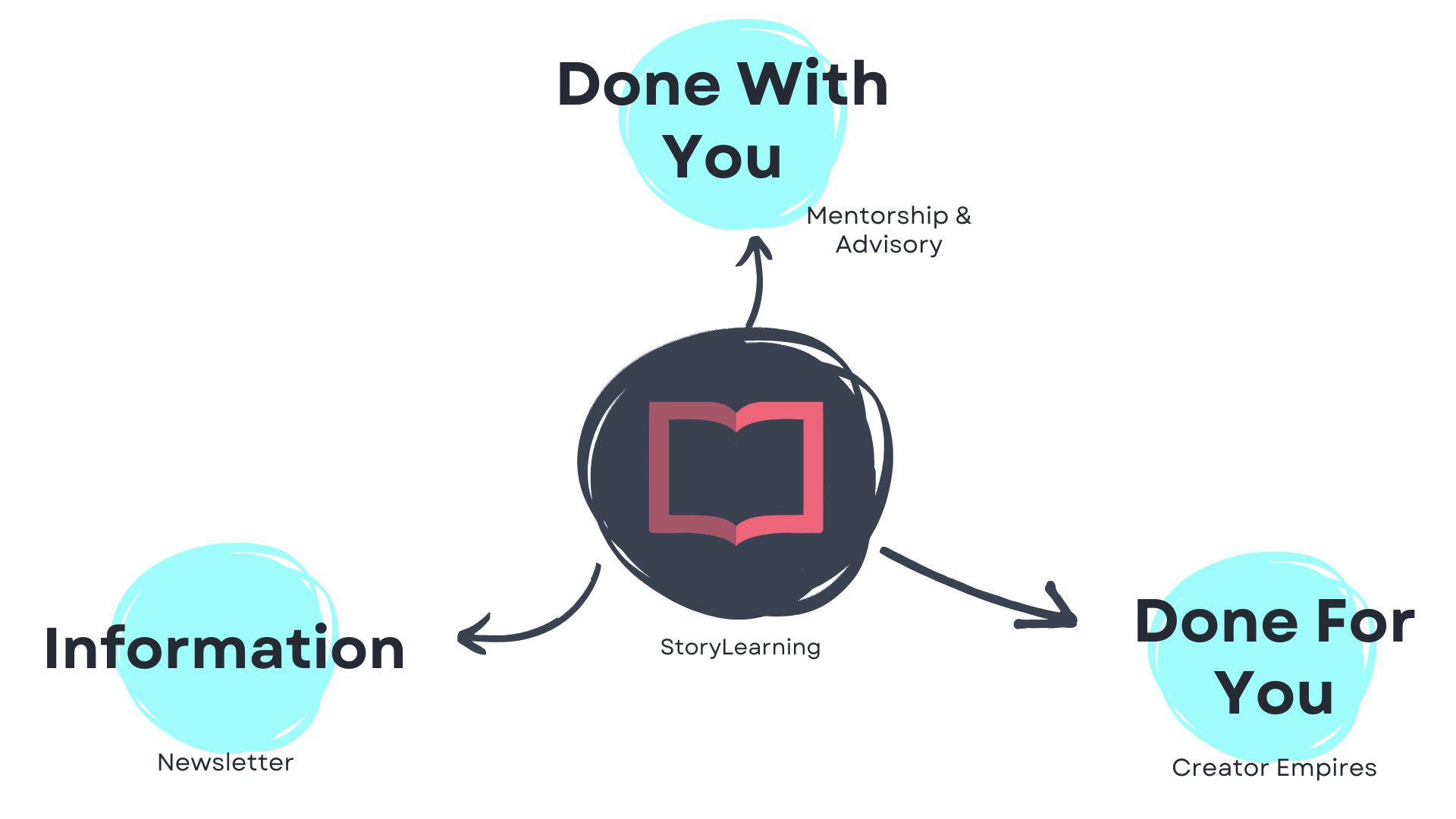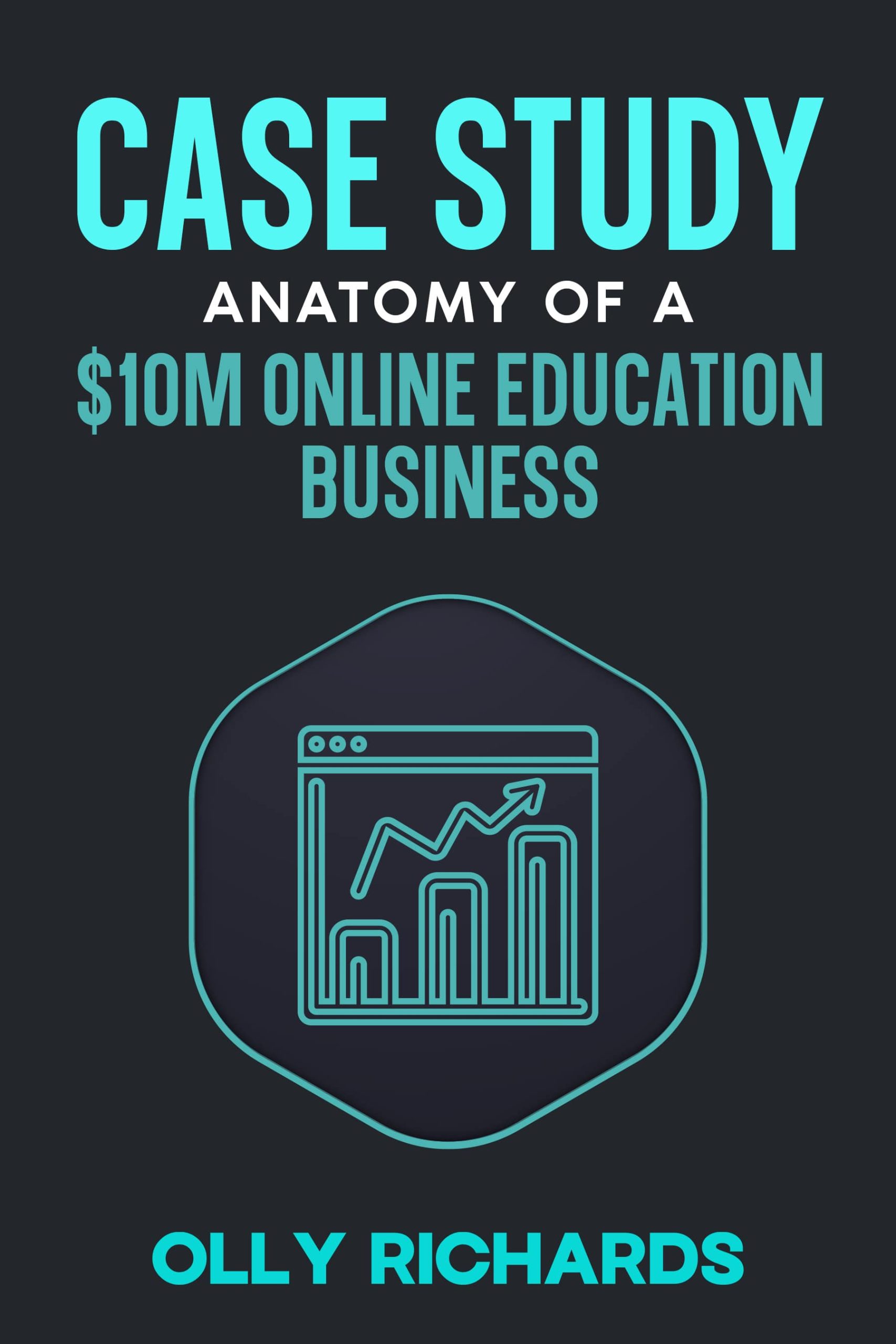Some time in 2020, I felt a shift brewing inside me.
Perhaps it was pandemic-induced cabin fever.
Maybe it was an early mid-life crisis.
There I was, plugging away inside StoryLearning (my language learning business), when a thought hit me like a lightning strike on a clear day:
I spend far more time thinking about business than about languages!
Now this is nothing new…
This happens to all expert businesses eventually:

Your job inevitably ends up becoming less about the thing you teach, and more about business and marketing.
When I first started, I was teaching languages all by myself…
But I eventually crafted a “system” around my teaching so slick, that I wrote myself clean out of the business!
To many entrepreneurs, this feels like the dream!
But the day it happens, it’s a strange affair.
I started to feel out of alignment…
I realized that my biggest “personal store of value” was not in languages, but rather in business…
And I wasn’t using my expertise to its full potential.
So as my time freed up, I started asking how I could use my knowledge to build future value, outside the confines of the main business.
Today, I’ll tell you what I did.
So if you ever wonder what the future holds for you, you might get some inspiration to develop your own future business career.
Mapping Your Personal Expertise
So, to recap the challenge:
- My time commitment to my business was reducing
- I’d built significant expertise in a new domain (business and entrepreneurship)
- I wanted to make better use of this knowledge
- …without creating a bunch of new jobs for myself!
To put it plainly, my expertise in business was becoming so valuable that it was inevitably going to become more valuable than my language knowledge.
(It stands to reason, right? If I could make 7-figures with a language business, what’s the value of my business knowledge?)
Anyway…
From the above list, point #4 was key.
As you know, my whole business philosophy is that entrepreneurship gives you the opportunity to create the life you want, to be lived right now – today! – not in some far off, hypothetical retirement.
So it took some time to figure out the model, which I’ll show you now:

In this diagram, you can see the three ways I’ve decided to deploy my expertise since my pandemic epiphany.
In the centre is my business StoryLearning.
That’s the source of the expertise I’ve built, but also my most visible credibility.
(And I feel the credibility piece is key – the marketing world is so slimy, most people’s default mode is skepticism. “Who are you anyway?” My advantage is that I can simply point to an actual, real-world business and say “Do as I do, not as I say.”)
It’s this knowledge I felt had been under-exploited.
Stemming from that centre piece are three things:
- Teach
- Collaborate
- Do
Let’s look at each.
1. Teach - The OllyRichards.co newsletter
This one is the most straightforward.
Put simply:
Everything I write about in this newsletter is stuff I’m already thinking about on a daily basis anyway.
What I’m preaching here are the strategies and tactics we use inside StoryLearning, partner companies, or mindset lessons I’ve learnt myself from tackling the whole kit and caboodle.
So it’s really no big deal to put it down on paper and send it out to y’all.
In fact, writing this newsletter actually helps me in all kinds of areas, because it helps me organize my thoughts.
So here, I’m deploying my expertise by teaching it.
As I explained in my growth philosophy, I’m making the newsletter completely free, so it’s not a business as such…
But via the audience growth, there is a business-in-waiting which I expect to be a $5M/yr business with $3M profit… within the next 2-3 years… if I choose to.
Point is, it’s building optionality for the future.
2. Collaborate
This third leg of the stool is a fusion of #1 and #2.
- Mentorship
- Advisory
- Investing
It’s a way of engaging directly with people who want access to my knowledge in one way or another, and want to do the work themselves.
The reason I do this is that it’s a way to attract smart people into my orbit.
Smart people see the value in spending good money on access to knowledge, so having someone who’s willing to either spend a lot of money, or else offer equity, is a highly-effective filtering mechanism for someone I’m likely to become friends or business partners with in the future.
I know all this because…
I’ve clocked this very dance in my own behavior!
One of my business partners today is someone I previously spent 6-figures with as a mentor. Our relationship developed from that.
(Tip: Everyone always asks how to find a business mentor. Best way? Find someone you want to learn from and buy all their stuff.)
So, it’s fun.
But it also generates direct cash that I can put back into growth.
So much of the building I’m doing at the moment is pushing profit down the road for the sake of building in the here-and-now, but it’s always healthy to keep some cash flow moving.
It’s also the best way to forge relationships with smart people, and the ROI on that is intangible.
3. Do - CreatorEmpires.com
This is the practical, hands-on side of things.
I’m co-founder of Creator Empires, where we partner with top creators to build out educational products for them.
Let’s say you’re a YouTuber with 5 million subscribers, we partner with you to build out an entire course ecosystem based on your niche.
For example, if you make videos about playing the guitar, we would build out a guitar “academy” for your students.
You bring the traffic, we create the monetization.
The result?
Sparks fly!
So, whereas in the newsletter, I’m teaching people how to do stuff themselves…
In this business we do everything for them.
This was an obvious direction to go in for a few reasons:
- I know how to build education businesses and have the credibility from StoryLearning and other partners
- I have a big network of people in the industry
But, crucially…
- My business partner runs operations, so I’m not involved in the day-to-day
Good vibes.
Three Modalities of Information
Now, you may think that the three things I showed you in the last section were random…
Or just cute ideas.
But there’s actually a deeper logic to it, which might help you in structuring your knowledge, or even your whole business.
The three legs of the stool map closely to a standard way of deploying information in the agency model:
- Information only
- Done with you (DWY)
- Done for you (DFY)

To spell it out…
Newsletter - This is information only. You pay for the information (or not, in this case), consume it and are on your own to take action
Mentorship & Advisory - Here, we introduce direct access. By helping to set strategy, discussing problems and challenges, this is kind of like a “done with you” (DWY) offer.
Creator Empires - We literally do all the work - in the trenches, building stuff out. Partners do very little, other than sending traffic to the assets we build. This is classic “done for you” (DFY).
This way of structuring services is a great way to make sure you’re offering a full value stack in what you do, because it caters to all different customer types.
Knowledge Needs To Flow
The point of talking about myself today (my fave topic!), was to get you to think about the total, global value of your expertise…
And the ways you might not be using it to its full potential.
In my case, I realised that I was developing more expertise in business, than in the languages I teach.
So I decided to start to “seed” other activities that would allow me to use that expertise in valuable ways…
Without piling on new work for myself!
I did this by:
- Teaching through this newsletter (I’m thinking about this stuff anyway, so writing it isn’t a big deal.)
- Doing it for other people - building course ecosystems for creators who need them (I can do it better than anyone)
- Collaborating with other businesses through mentorship, advisory and investing. (Extremely high ROI on my time)
Having done this, a few things have happened…
First, I feel a lot more fulfilled in my day-to-day, because as a teacher I need to put my thoughts out into the world, rather than having them caged up.
(For me, knowledge is like money – it has to flow, or it starts to cause problems.)
Second, I’ve been able to have a material impact on other entrepreneurs through partnerships. (We don’t talk about our partner companies, but it’s safe to say you’ve seen them.)
Third, I’ve had some wonderful people come into my life as a result of the direct work I’ve been doing, who I’ve learnt a lot from as well. (People who seek your help tend to be a lot like you.)
Candidly, this activity hasn’t resulted in much income so far.
But that’s just because I haven’t chosen to pull the lever yet.
It’s far more important for me to feel like I’m using my mind to its full potential.
Not stagnating.
Know what I mean?
And so, like I said in my strategy outline, I’m perfectly happy just meandering through the meadows, scattering seeds everywhere I go, coming back to water them, and trusting 100% that this will all yield a king’s ransom of worth in the long term.
Trusting the process is the biggest point of long-term growth.
Before I finish, a word of warning:
I only recommend paying attention to any of this stuff if you’re already doing multiple 7-figures in revenue.
If you’re sub $1M, you need to stay focused on your main business.
This is because diversification is a MAJOR shiny object that will stop your business dead in its tracks if you pursue it at the wrong time.
(I go into depth about this in chapter 9 of the case study.)
But if you’re at the helm of a mature business, where you have the space to think about other things, here are some questions to reflect on:
- Where have I developed “hidden” expertise that I’m not using professionally?
- Does this have real-world value?
- How can I seed this knowledge in an enjoyable way to create future options?
Right.
That’s it.
It’s Wednesday morning, 09:27am as I write this, and I’m off out for some coffee and sea views.
Quick favour -- got any friends with successful, mature businesses? Please send this article on to them.
Or leave me a comment below.
Yeah, I know it's the 21st Century, but blog comments are still a thang!
Namaste,
Olly
CASE STUDY: Blueprint Of A $10m Online Education Business:
Join my free newsletter for online educators and I'll send you the case study immediately...
We will protect your data in accordance with our data policy!

